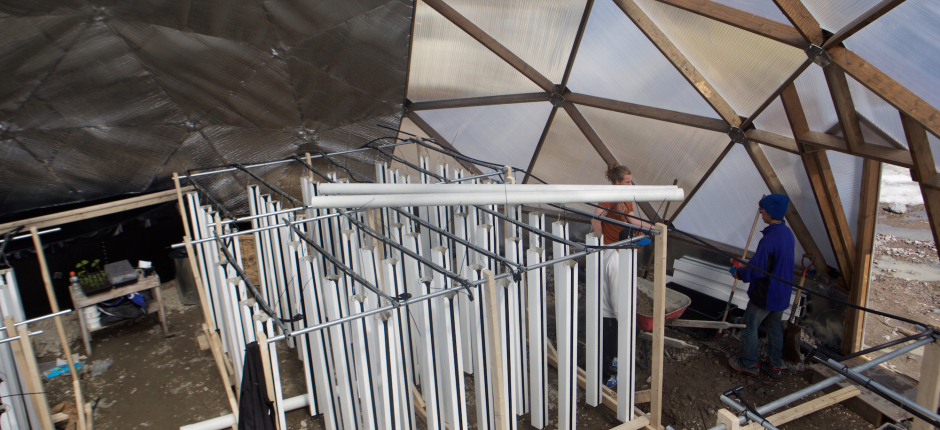Can greenhouses take root in Nunavut?

Even with its 24 hours of sunlight in the summer, gardening in Nunavut has a lot going against it: topsoil, where it exists, is poor, and temperatures below freezing are a year-round occurrence. Limited local experience is another hindrance.
Moving operations inside is an obvious solution, that, according to a 2013 report, commissioned by the federal government, is entirely feasible. The comprehensive review of the economics, technology and social aspects of green-housing in northern Canada found that even small-scale greenhouses could make a contribution to food security, especially in small communities, if they were run properly. Still, with high prices for just about everything needed to make them work, from seeds to energy, they remain exotic.
Nevertheless, green-housing is an idea that persists among supporters, who believe that producing food locally can contribute to food security in a region where supermarket prices are gut-wrenchingly high, and where traditional hunting is no longer a viable option for most.
For those communities that can make green-housing work, the benefits, according to Growing North, a Toronto-based outfit that in 2016 provided the funding to build a greenhouse in the hamlet of Naujaat, could be significant.
Prior to setting up the Naujaat greenhouse, a geodesic dome rising four meters above the ground, the organization estimated that it would be able to provide half of the community of 2,600 with vegetables on a daily basis. In specific terms, this would be about 6,000 kg of potatoes annually, reckons Stefany Nieto, the Growing North co-founder.
Getting this much out of the greenhouse, she reckons, will take some experience. But the learning process, and allowing the community to take responsibility for its own food production, she points out, is as much a part of the point of the project as producing food.
“There is something inspiring about making something previously impossible possible,” she says.
One of the issues looked at the in the 2013 report, as well as in a set of guidelines produced by the University of Saskatchewan in 2012, was community involvement, and the question of making sure that greenhouses satisfy local needs. Both reports point out that demand will vary from location to location. For cultural reasons, areas with larger populations of southerners, such as Iqaluit, the capital, are likelier to have an easier go of it, for example.
To help ensure the Naujaat greenhouse produces food people want, Growing North left most of the details up to residents. All of the farming is done by residents, for example, and students who take part receive credit and gain work experience, which according to Nieto, ensures that it is accepted.
“The point is not for us to work for the community,” she says, “it is to work with the community. Our team is down south most of the year, so the greenhouse needs to be something they want and are interested in running on their own.”
The organization is now working on setting up a second greenhouse, this one comprising two domes, in Arviat. A third hamlet will probably be added soon after. As with Naujaat, new communities are chosen carefully, based on their need, and, most importantly, on whether they want a greenhouse in the first place.
For those communities that do decide to try their hand at growing their own food, it will be up to residents to decide what to plant and how it gets distributed. In Naujaat, the produce is sold at a farmers market. In Arviat, it is likely to get distributed to the neediest families for free. Nieto says another model could be a collaboration with local grocery stores.
The greenhouse in Naujaat, a relatively sturdy model that can withstand winds of up to 110 km/h and more than 2 meters of snow, cost C$160,000 ($116,000) to purchase and have shipped. Operating it costs C$17,000 annually. Both are expected to come down as the organization and communities become more efficient.
Other greenhouses exist, but their experience shows that success requires patience. The Iqaluit Greenhouse Society, for example, was formed in 2001, but did not have enough money to build its 100-square-meter greenhouse until 2007.
The next greenhouse to see the light of day will, in all likelihood, be in the hamlet of Qikiqtarjuaq. In a sign that green-housing is being embraced as a realistic option, local school teacher Adam Malcolm raised C$19,425 to purchase a greenhouse and equipment that he can use to teach students how to grown their own fruit and veg. The goal of his online campaign was C$4,500.
The money, he says, has come from throughout Canada, and he has been contacted by firms from southern Canada and the U.S. looking to donate seeds and other equipment. But he says there is also plenty of local support for the idea.
“Greenhouses aren’t new,” he says, “but they’ve never been tried here before and people are curious to see if it can work.”
For now, the greenhouse is strictly a school project. Malcolm will give his pupils guidance, but it has been up to them to decide what to grow and what to do with the food. He admits, though, that the idea behind it is to find a way to shore up the community’s food supply.
“At its best, it will never be more than a supplement, but that still might make the difference between having enough to eat and being hungry.”
One more good reason to eat your vegetables.